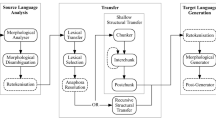Abstract
In 1954, with his article entitled Transfer Grammar (published in “The International Journal of American Linguistics”, Vol. 20, No. 4, pp. 259–270, University of Chicago Press), Zellig S. Harris was the first linguist to approach the nascent Automatic Translation (AT) from the point of view of structuralist and formal linguistics. This article, written in the pivotal period for the first AT attempts in the US, outlines a translation method that wants to:
-
Formally measure the difference between languages, in terms of grammatical structures;
-
Define the point of minimum difference (or maximum similarity) between any type of language pair;
-
Define the difference between the languages as the number and content of grammatical instructions needed to generate the utterances of one language from the utterances of the other.
At the time, the purposes of Harris’s article were therefore extremely innovative, since they considered translation as a process in which meaning transfers could only be achieved based on morphosyntactic analyses and evaluations. Moreover, it is worth stressing that at the time the first AT experiments performed word-for-word translations, without taking into account (not even statistically) the contexts in which the words co-occurred. As is known, this method proved to be unsuccessful, as regards the quality, time and costs of the translations made automatically. In 1966, this led ALPAC [1] to end AT research in the US, and cut off the flow of funding to it.
Access this chapter
Tax calculation will be finalised at checkout
Purchases are for personal use only
Similar content being viewed by others
Notes
- 1.
As for this study, listing other types of Google Translate errors would require a large number of pages. For summarizing purposes only, we indicate here some of them, i.e. erroneous translations of: idioms and frozen sentences; well-known prose and poetry passages already translated into many languages; both simple and terminological compound words. Besides, it is very important to underline that similar errors occur with languages that are not low-use, but with a high number of speakers in the world, such as English, French and Italian.
- 2.
Per se, NMT limits mainly depend on the fact that Neuroscience research has not yet been able to establish how Natural Neural Networks work. There is therefore no model to replicate, and the distance between the functioning of Artificial and Natural Neural Networks is still very evident and remarkable, as for language and translation production. Therefore, it ensures that NMT works well with simple texts, formed by short sentences and free of semantic violations, as regards the rules of co-occurrence and selection restriction established by Lexicon-Grammar [9].
- 3.
Currently, this article is included in the reprint of Papers in Structural and Transformational Linguistics [10].
- 4.
IBM was the first major company to build a computer, called The Brain, specifically intended for machine translation. In 1954, IBM and Georgetown University teamed to produce the first English-to-Russian language computer translation program [12].
- 5.
AT was hence decontextualized, and it worked only for sentences/phrases with strictly compositional semantics. Due to the many errors produced, every translation had to be double-checked by human translators. This led AT to have higher costs than fully human ones, also in terms of time required.
- 6.
This method might also be relevant for the learning or teaching of foreign languages, proving possible to acquire a language by learning only the differences between the new language and the old.
- 7.
However, according to Harris, investigating the structural differences between languages does not suffice to define distance among their structures. For instance, it will not be possible to state that the difference between English and German is some specified function of the English- Danish and the Danish-German differences. [16, p. 157].
- 8.
To a certain extent, albeit unintentionally, here Harris seems to predict all the problems which today backtranslation creates in almost all machine-translation tools and systems.
- 9.
Here, due to the pre-established number of pages at our disposal, we will focus only on the first and less complex method, i.e. the one that uses instructions inside NooJ grammars.
- 10.
Each of the figures that follow include at the bottom a debug window used in NooJ to verify if the instructions inserted inside the specific grammars are correct. If there are no errors, the language elements being debugged will appear in green.
References
https://nap.nationalacademies.org/resource/alpac_lm/ARC000005.pdf. Accessed 25 Sept 2022
Silberztein, M.: The NooJ Manual (2006). http://www.nooj-association.org. Accessed 17 Sept 2022
Silberztein, M.: Formalizing Natural Languages: The NooJ Approach. ISTE Ltd and Wiley, London (2016)
https://en.wikipedia.org/wiki/Lexicon-grammar. Accessed 23 Sept 2022
https://www.makeuseof.com/tag/best-online-translators/. Accessed 17 Sept 2022
https://weglot.com/blog/machine-translation-software/. Accessed 17 Sept 2022
https://en.wikipedia.org/wiki/Artificial_neural_network. Accessed 17 Sept 2022
https://en.wikipedia.org/wiki/Google_Neural_Machine_Translation. Accessed 17 Sept 2022
Gross, M.: Grammaire Transformationnelle du Français: Tome 1 - Syntaxe du Verbe. Cantilène, Paris (1968)
https://link.springer.com/book/10.1007/978-94-017-6059-1. Accessed 17 Sept 2022
https://en.wikipedia.org/wiki/History_of_machine_translation. Accessed 17 Sept 2022
https://en.wikipedia.org/wiki/Georgetown%E2%80%93IBM_experiment. Accessed 17 Sept 2022
https://www.freecodecamp.org/news/a-history-of-machine-translation-from-the-cold-war-to-deep-learning-f1d335ce8b5/. Accessed 17 Sept 2022
https://en.wikipedia.org/wiki/ALPAC. Accessed 17 Sept 2022
Harris, Z.S.: Transfer grammar. Int. J. Am. Linguist. 20(4), 259–270 (1954)
Author information
Authors and Affiliations
Corresponding author
Editor information
Editors and Affiliations
Rights and permissions
Copyright information
© 2022 Springer Nature Switzerland AG
About this paper
Cite this paper
Monteleone, M. (2022). Zellig S. Harris’ Transfer Grammar and Its Application with NooJ. In: González, M., Reyes, S.S., Rodrigo, A., Silberztein, M. (eds) Formalizing Natural Languages: Applications to Natural Language Processing and Digital Humanities. NooJ 2022. Communications in Computer and Information Science, vol 1758. Springer, Cham. https://doi.org/10.1007/978-3-031-23317-3_6
Download citation
DOI: https://doi.org/10.1007/978-3-031-23317-3_6
Published:
Publisher Name: Springer, Cham
Print ISBN: 978-3-031-23316-6
Online ISBN: 978-3-031-23317-3
eBook Packages: Computer ScienceComputer Science (R0)




